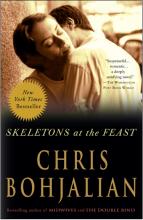Skeletons at the Feast
 |
Reviewed by Helen von Schmidt ’78
Over the course of 11 novels, Chris Bohjalian, with deepening insight and narrative power, has been showing us the people we live among—those with whom we share, not always with generosity, the world in which we exist. His own empathy and generosity have worked to enlarge our sympathies for all sides.
In 1998, a friend showed Bohjalian the diary, kept from 1920 through 1945, of an East Prussian woman. It chronicled her family’s difficult trek west, ahead of the Soviet advance, in the last year of World War II. In 2006, after reading a history of that era, Max Hasting’s Armageddon, Bohjalian began work on the novel that would become Skeletons at the Feast.
Here, for the first time, Bohjalian moves back into history, into that last year of World War II; that move alone entails a risk for the novelist, but the greater risk comes, perhaps, in trying to sustain that generosity. However we question those among us who see our world differently, our questions tend to be harsher toward those removed by history: “How can they not have known? How, knowing, could they act as they did?”
It’s midwinter in 1944. In what was once Germany, then Poland and now Germany again, the Emmerich family begins what will be an arduous journey. The oldest son is already on the Eastern front; now the father and the second son are called up to join a last, hopeless effort to stop “Ivan.” The others are setting out for the west: Mutti, who will leave behind her much-loved, signed, ribbon-framed picture of Adolf Hitler; Anne, the daughter, on the cusp of womanhood and increasingly aware of a wider world outside the farm; and Theo, the beloved youngest son, who, isolated by his peers, has found refuge in re-enacting with his toy soldiers the battles of earlier wars. Too young, his family believes, to be made fully aware of their predicament, Theo is wise and sensitive enough to try to make sense of what he sees and overhears.
They are not wholly without a protector: traveling with the family is Callum, a Scots P.O.W. left on the Emmerich farm, thanks to the father’s connections, when the rest of a work crew was taken back to its stalag. Callum is a soldier who’s never fired a shot, captured and imprisoned almost immediately after he parachuted into Germany. However, he is young and strong; more importantly, he will be the family’s “goodwill offering” when they reach either the British or American army. He is also Anne Emmerich’s lover, something Theo knows and Mutti finds it convenient to ignore.
As the family joins the chaotic mass of people lining the banks of the Vistula, desperate to cross the river westward ahead of the advancing Russians, “beetles scurrying from a giant’s boots,” they are joined by the man they will know as Manfred. His uniform suggests that he is a German deserter; in fact, he is Uri Singer, two years on the run. He escaped from an Auschwitz-bound train, leaping through a door briefly opened to shovel out human waste. Since then, he has taken on the various identities of those whom he has found or left dead in order to survive.
The final thread in Bohjalian’s narrative is Cecile’s story. She is a French Jew, now part of a forced march from the work camp where she has spent the war to what she hopes will be another labor site but rightly fears is simply a journey to slow death. Cecile has survived this long in part because, on the advice of others, she’s brought along her fiancé’s work boots; the crocodile flats she couldn’t bear to leave behind serve to keep her friend alive. Cecile’s path will ultimately join that of the Emmerich family.
Converging paths; converging destinies. Each character is tested, not only by the harrowing circumstances of the journey but by the questions they must ultimately face. For Mutti, the test comes when she asks Uri, “Who have you met? What have you seen?” “It’s not just the soldiers,” he replies. “It’s the whole German people.”
Wim Wenders, in a tribute to Yasujiro Ozu, praises the Japanese filmmaker’s ability to “present an image of man in our century, a usable, true and valid image in which he not only recognizes himself but from which above all he may learn about himself.” The questions in Skeletons at the Feast serve a similar purpose.
Read an excerpt at here.
Von Schmidt is a senior lecturer in English at Amherst.
Additional Reviews
Washington Post
The Boston Globe
L.A. Times
Praise on Chris Bohjalian's site